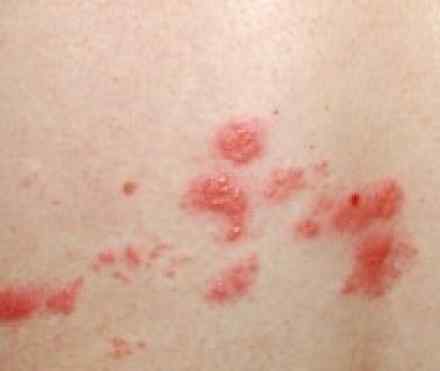
What is it?
Shingles is a viral infection that causes a painful rash. Although shingles can occur anywhere on your body, it most often appears as a band of blisters that wraps from the middle of your back around one side of your chest to your breastbone.
Shingles is caused by the varicella-zoster virus — the same virus that causes chickenpox. After you've had chickenpox, the virus lies inactive in nerve tissue near your spinal cord and brain. Years later, the virus may reactivate as shingles.
While it isn't a life-threatening condition, shingles can be very painful. Vaccines can help reduce the risk of shingles, while early treatment can help shorten a shingles infection and lessen the chance of complications.
Symptoms
The signs and symptoms of shingles usually affect only a small section of one side of your body. These signs and symptoms may include:
- Pain, burning, numbness or tingling
- A red rash that begins a few days after the pain
- Fluid-filled blisters that break open and crust over
- Itching
Some people also experience:
Pain is usually the first symptom of shingles. For some, it can be intense. Depending upon the location of the pain, it can sometimes be mistaken for a symptom of problems affecting the heart, lungs or kidneys. Some people experience shingles pain without ever developing the rash.
Most commonly, the shingles rash develops as a band of blisters that wraps around one side of your chest from your spine to your breastbone. Sometimes the shingles rash occurs around one eye or on one side of the neck or face.
Causes
Shingles is caused by the varicella-zoster virus — the same virus that causes chickenpox. Anyone who's had chickenpox may develop shingles. After you recover from chickenpox, the virus can enter your nervous system and lie hidden for years. Eventually, it may reactivate and travel along nerve pathways to your skin — producing shingles.
The reason for the encore is unclear. But it may be due to lowered immunity to infections as you grow older. Shingles is more common in older adults and in people who have weak immune systems.
Varicella-zoster is part of a group of viruses called herpes viruses, which includes the viruses that cause cold sores and genital herpes. Because of this, shingles is also known as herpes zoster. But the virus that causes chickenpox and shingles is not the same virus responsible for cold sores or genital herpes, a sexually transmitted disease.
Are you contagious?
A person with shingles can pass the varicella-zoster virus to anyone who hasn't had chickenpox. This usually occurs through direct contact with the open sores of the shingles rash. Once infected, the person will develop chickenpox, however, not shingles.
Chickenpox can be dangerous for some groups of people. Until your shingles blisters scab over, you are contagious and should avoid physical contact with:
- Anyone who has a weak immune system
- Newborns
- Pregnant women
Risk factors
Having had chickenpox
Anyone who has ever had chickenpox can develop shingles. Most adults in the United States had chickenpox when they were children, before the advent of the routine childhood vaccination that now protects against chickenpox.
Age
Shingles is most common in people over the age of 50. The risk increases with age. Some experts estimate that half the people who live to the age of 85 will experience shingles at some point in their lives.
Weakened immune systems
People with weakened immune systems are at higher risk for developing shingles. A weakened immune system can be caused by:
- HIV/AIDS
- Cancer or cancer treatments, such as radiation and chemotherapy
- Prolonged use of steroids, such as prednisone
- Drugs designed to prevent rejection of transplanted organs
Complications
Complications from shingles can range from a mild to severe, ranging from minor skin infections to postherpetic neuralgia.
Postherpetic neuralgia
For some people, shingles pain continues long after the blisters have cleared. This condition is known as postherpetic neuralgia, and it occurs when damaged nerve fibers send confused and exaggerated messages of pain from your skin to your brain. Pain medication, antidepressants or anticonvulsant medications may help provide relief until the pain subsides.
Vision loss
Shingles in or around an eye (ophthalmic shingles) can cause painful eye infections that may result in vision loss.
Neurological problems
Depending upon which nerves are affected, shingles can cause:
- Encephalitis, an inflammation of the brain
- Hearing or balance problems
- Facial paralysis
Skin infections
If shingles blisters aren't properly treated, bacterial skin infections may develop.
Diagnosis
Shingles is usually diagnosed based on the history of pain on one side of your body, along with the telltale rash and blisters. Your doctor may also take a tissue scraping or culture of the blisters for examination in the laboratory.
References
https://www.hse.ie/eng/health/az/S/Shingles/Introduction.html
http://www.uptodate.com/contents/treatment-of-herpes-zoster-in-the-immunocompetent-host?source=search_result&search=shingles&selectedTitle=1%7E150
http://www.irishhealth.com/article.html?con=408
http://bestpractice.bmj.com/best-practice/pdf/patient-summaries/patient-summary-1197024888508.pdf



